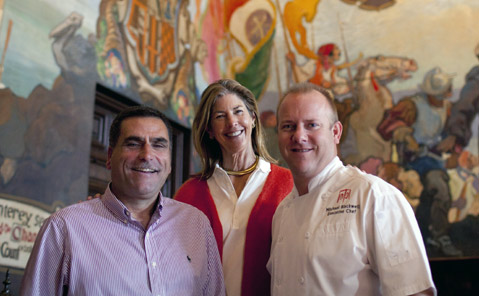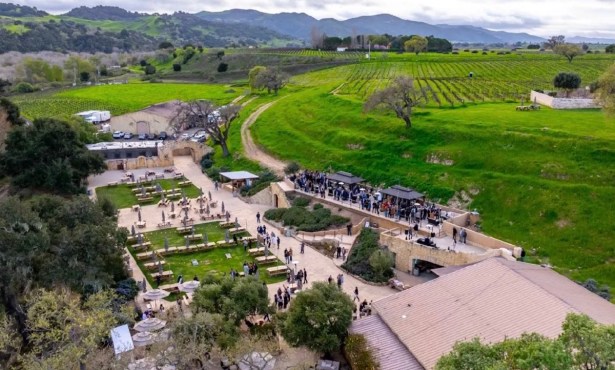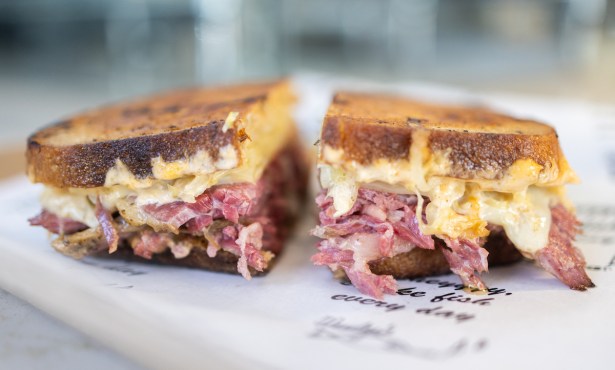Eating History in the Courthouse Mural Room
Casa del Herrero and California Missions Foundation Host Four-Nation Dinner

Santa Barbarans are well attuned to learning about this region’s fascinating history through our eyes and ears, but what about our mouths? What if you could taste the past, from the Chumash days through the Spanish, Mexican, and American eras?
That’s the goal of an upcoming dinner in the County Courthouse’s recently re-polished Mural Room, where a few dozen history-hungry souls will enjoy a four-course dinner called Food Anthropology: The Four Nations of Santa Barbara. A benefit for Casa del Herrero — the Montecito mansion turned museum that’s credited with inspiring the city’s dominant red-tile-roof architecture — the October 23 event is being hosted by the Casa trustee Sharon Bradford, the California Missions Foundation’s executive director David Bolton, and Chef Michael Blackwell as part of epicure.sb, the annual monthlong celebration of culinary culture in October.
Blackwell and Bolton put on a similar affair back in April, with a candlelight dinner inside the Presidio Chapel. After putting together Mural Room–reflective floats for the Old Spanish Days Fiesta Parade, Bolton realized that the murals truly depict the four stages of Santa Barbara, from Chumash and Spanish to Mexican and American. “How cool would it be if we could have a four-course dinner with each of those nations that have ruled Santa Barbara at one time represented and presented in a way that unveils the chronological history in sequence?” he wondered, and then set about designing a dinner to “shine a culinary light across the ages.”
It wasn’t easy. “Part of the challenge was finding items that appeal to everybody,” said Bolton. “Since the Spanish first arrived over 225 years ago, there’s been a culinary evolution. We didn’t want to just give a dish that necessarily would have been eaten at the time, but rather honor the culture in that course with flavors and overall themes that would have been used at the time.”
But Bolton and Blackwell managed to develop quite an impressive menu, and as each dish is served, they will discuss how it relates to the walls of the Mural Room. “People will be able to taste, see, and hear, bringing all the senses together,” said Bolton. “Everyone hopefully will leave with the feeling that this was not only a food experience but a history experience and, more than anything, that it was something different.”
Here’s a look at the menu and wine pairings, along with Bolton’s comments on each dish.
First Course: Chumash
Smoked Duck Breast Salad, with Mixed Greens, Dried Cherries, Toasted Pine Nuts, and a Prickly Pear Vinaigrette: “The logical one would have been abalone, but when you are doing a dinner for 60-80 people, you find people that don’t do seafood,” explained Bolton. “The Chumash were big on native greens, but those usually come out in earnest in spring and early summer. Acorn mush was common, but it’s not the most flavorful and a complicated dish to do well. The native culture is also big on the game of wild animals, things like venison and duck. Chef Michael Blackwell thought a duck salad would be something that brought in the wild-animal-type diet and honor the natural plants that would have been part of the Chumash diet, as well.”
Second Course: Spanish
Chile Piquillo Relleno with Chorizo-Goat Cheese Stuffed Piquillo Pepper: “Soups are really hard to do in a mobile kitchen for that many people, so we ruled that out, and we didn’t want to do paella since we were trying to avoid seafood,” said Bolton. “So Chef Michael came up with this piquillo pepper that will be roasted soft and filled with goat cheese and chorizo, which are very Spanish.”
Third Course: Mexican
Cumin-Dusted Beef Fillet with Roasted Corn, Pasilla Chile, Tomato, and Black Bean Guisado: “With this dinner coming soon after Fiesta, when everyone had tacos and enchiladas, we didn’t want to go that route,” said Bolton. “I was very happy when Chef Michael suggested a filet because he is a very good preparer of steak — he even cooked two years ago for Prince Felipe of Spain, now King Felipe, and every one of his steaks for 150 in the room was cooked perfectly.
“So we have a filet lightly dusted with ground cumin, which is a flavor used widely in Mexico,” said Bolton. “It’s accompanied by a guisado, which is a blend of corn (which dates back to pre-Hispanic times in Meso-America); tomato (which is very much from the Americas); black beans (which have also been around Mexico for centuries); and pasilla chile, which is one step up from a bell pepper. The pasilla is what most people in Mexico use in cooking. Not everyone likes spicy, so they use pasilla chiles and usually have salsa on the side made of serrano or jalapeños for family members who want more spice.
“That guisado is really something that brings together all the vegetable flavors that came out of Mexico,” he continued. “I came up with the dish about six years ago. It is beautiful in color — red, green, black, yellow. Paired with a nice filet, it will give you a truly elegant, quality Mexican plate.”
4·1·1
Casa del Herrero’s Food Anthropology benefit dinner is 6-9 p.m. on Friday, October 23, inside the County Courthouse’s Mural Room (1100 Anacapa St., 2nd floor) as part of epicure.sb. See epicuresb.com or call 565-5653 to buy the $200 tickets.



